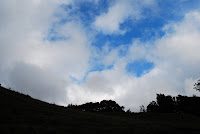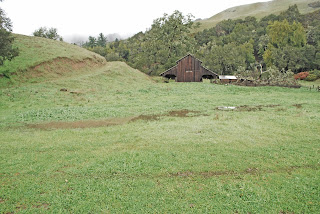 We've had one storm after another rolling in since Thursday. A low pressure system off the Pacific Ocean has been lining them up and aiming them onshore in a northeasterly direction. That's what the National Weather Station says and I independently corroborated this with my local weather station, a leaky window on the southwest side of the house. On a clear day, you can look out same window through gaps in the local mountain ranges to see the northernmost tips of the Santa Lucia Range, 200 miles further down the California coast. Hail pounding on that window on recent evenings reminded me that ocean-bred weather systems move inland through the same alleyways, and to put another towel on the sill.
We've had one storm after another rolling in since Thursday. A low pressure system off the Pacific Ocean has been lining them up and aiming them onshore in a northeasterly direction. That's what the National Weather Station says and I independently corroborated this with my local weather station, a leaky window on the southwest side of the house. On a clear day, you can look out same window through gaps in the local mountain ranges to see the northernmost tips of the Santa Lucia Range, 200 miles further down the California coast. Hail pounding on that window on recent evenings reminded me that ocean-bred weather systems move inland through the same alleyways, and to put another towel on the sill.With 5.5 inches of precipitation in the last 48 hours, the creeks are flowing, ponds are filling and some are spilling over. I'm not complaining. We need the rain. I alternate between cheering the rain on and looking for gaps between storms when I can check the ponds. I don't mind hiking and working in the rain, as long as I am working hard enough to evaporate off whatever soaks through the layers. I just wasn't looking forward to sliding all the way down muddy roads to the ponds nor slipping across wet pastures on the way
 back.
back.--- Water flows down grassy hillsides to the Plum Pond --->
Yesterday, M10 came by with the mule to do road and water checks, so we drove down to the Plum Pond to check recent repairs. An old culvert had collapsed under a road and they replaced it with a different diversion setup. So far this winter, the pond hadn't filled enough to test the new spillway and culvert. Watching flow patterns during a rainstorm is often the best way to learn how a hydrologic system works. Indeed, earlier that day, I'd been hoeing out thistles in the farmyard in a light rain and mulling over water rilling down the driveway.
The Plum Pond is fed by a small spring, but in a rainstorm, you can see how gravity sends water sheeting and streaming down the surrounding grassy hillsides and bubbling up old gopher holes too. Yesterday, the pond was full of cloudy water with one end steadily pouring through the new culvert. The construction work looked intact and was functioning well. Straw placed on top of the repaired road was preventing any erosion.

 <---Repair work at the Plum Pond holding up in heavy rains --->
<---Repair work at the Plum Pond holding up in heavy rains --->The water in the Plum Pond was too cloudy to detect the California red-legged frog eggs I saw last week or spot any new clusters. We heard a few peeps from Pacific treefrogs. The coast range newts were paddling about the cloudy water unconcerned. They have been in the pond long enough now that they are all swollen and cloudy themselves.

 <--- This newt was on his way to a pond in November and still had the bumpy, dark orange skin of the terrestrial phase ---
<--- This newt was on his way to a pond in November and still had the bumpy, dark orange skin of the terrestrial phase ------After being in the water for a few weeks, newt skin gets cloudy and smooth and their limbs swell, the aquatic phase --->
Other ponds have also formed around the abandoned Monotti barn. The Donut Pond (so called because it was excavated in an oval shape with an island in the middle) has shallow water on one side. A low spot in front of the barn (I call it the Barn Pond) is filling. The Barn Pond is so ephemeral, I rarely see any water there, but with more rain today, I can now see the Barn Pond all the way from the house.


--- Donut Pond and Barn Pond, shallow and muddy ---
The Newt Pond is three-quarters full with water pouring into it via a piped diversion placed at a nearby spring and drainage up the hill. I saw one newt along the water's edge but it was too cloudy to detect any others.

 <--- Newt Pond
<--- Newt Pond Diverted water pouring into the Newt Pond --->
Interestingly, the Woods Pond has very little water. The adjacent drainage is streaming down a steep section (the cattle operator just cleaned out a culvert above), and the pond's narrow spillway is draining, but not much water is actually settling in this pond. I haven't figured out its hydrology.

<--- The Woods Pond still has little water ---
After all this filling and spilling, last night, the tree frogs started their breeding din. I have heard a few tree frogs calling in the evening for the last few weeks. Mostly individual frogs setting up shop and testing out their voices. One clever fellow took over the metal cattle trough and has quite an echo going. But it was only last night that I can report the voices of many tree frogs joined into their annual "chorus" of breeding frenzy. They switch from a variety of notes to their "advertisement call", the repeating of two notes (kreek-ik) over and over again, egging each other on to get louder.
I did not make it to the Mallard Pond during this set of storms. I can imagine that it is spilling and the frogs are trilling. With my hardy core of curious volunteers, I expect to be checking the Mallard and other ponds for night-time frog surveys in the next few weeks.
See Also:
Coast range newt, Taricha torosa torosa
Pacifc treefrog, Pseudacris regilla
California red-legged frog, Rana draytonii
Hear audio tapes of California frogs and toads at California Herps website.

No comments:
Post a Comment
Comments let me know to keep on sharing what's happening at the Dipper Ranch. You can either use an existing account or choose "Anonymous" by clicking the arrow after the "Comment As" box. Your comment will appear after a delay to allow screening of spam.